Tango, the dance that started as a scandal and became the national dance of Argentina, is an immersive experience in music, passion, grace, and endurance. It includes scripted steps strung together with room for improvisation. I have now seen a grand total of one tango performance, but that won’t stop me from using it to make an analogy. With the help of a “learn to tango” blog, I’m going to attempt to connect the steps of tango dancing to the multi-step travel extravaganza we just completed.
In the last two weeks, we’ve been in Chile, Argentina, Uruguay, Mexico, and back to Chile. Four totally different currencies and exchange rates to keep track of, four completely different Spanish accents, and four passes through customs and immigration at widely varying levels of security. Oh, and a little bacterial infection leading to hospitalization in Uruguay just to spice things up. But that’s just a tiny taste of the past two months. Shall we dance?
Ocho (circular steps in the shape of a figure eight)
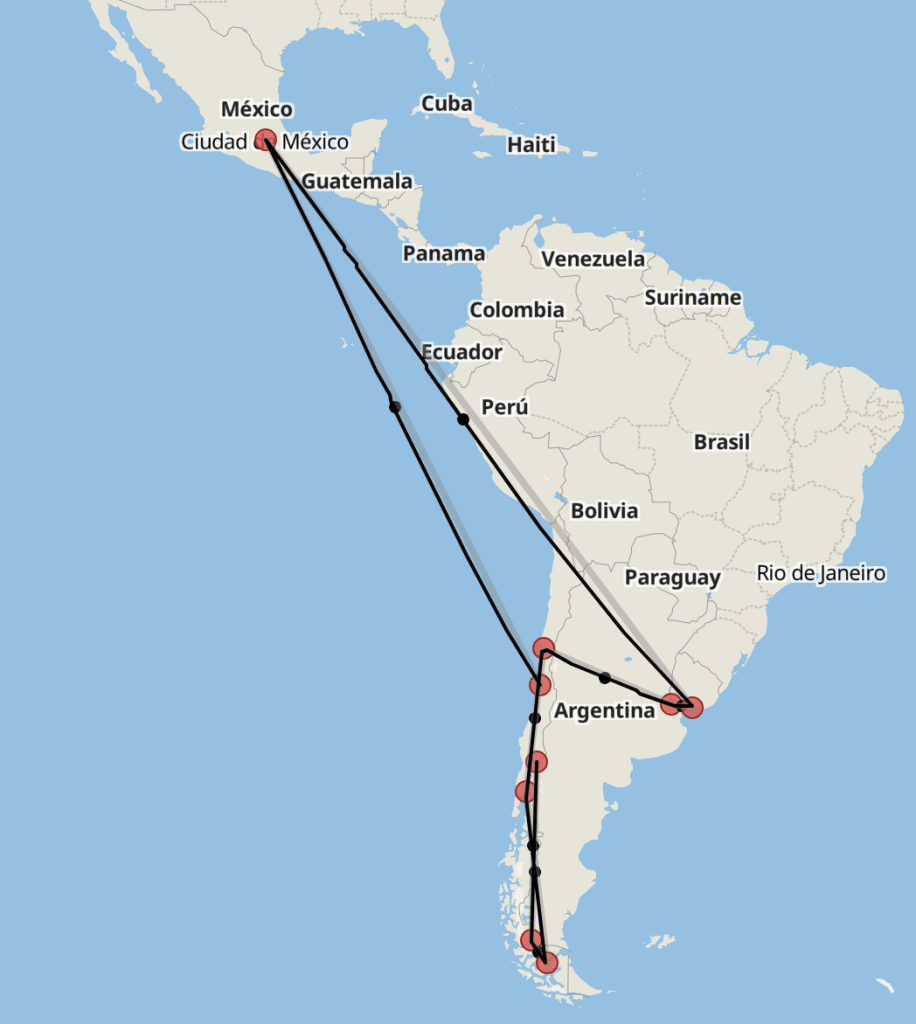
Eight weeks, thirteen destinations, 13,000 miles as the albatross flies. Since leaving our base in Pucón at the beginning of March, we have traveled by: bus to Puerto Montt, ship to Patagonia, bus to Argentina and back again, bus to Punta Arenas in the far south, plane back to Puerto Montt, car to close-by Puerto Varas, ferry to Chiloé Island, plane to La Serena (north of Santiago), bus to the Elqui Valley (at the southern end of Chile’s northern desert), plane to Buenos Aires on the Atlantic coast, boat to Montevideo, Uruguay, plane to Mexico City, plane to Santiago, and taxi to Valparaiso on the Pacific coast. Our carbon footprint is frightening to consider.
It’s no wonder we need a break. Back in February, looking ahead, we could see that we would need to stop and rest for a while after all this. Don’t get me wrong, it’s been an amazing two months, with such a wide range of sights and experiences it’s hard to know where to begin describing them. Add in extended visits with all of our kids in interesting parts of the world, and you’ve got a recipe for making treasured memories. But we’ve learned that it was also a recipe that was too much, too fast, and for too long. It’s time to stop, slow down, and just be.
Giro (a chain of steps linked together like a grapevine)
It all started simply enough. We wanted to explore more of Chile. We wanted to see our kids—some of whom could come to us, and some of whom were convening in Mexico City for Passover. As we plotted out everyone’s schedules and the places we wanted to see, our itinerary took shape. Ambitious, yes, but we figured we could handle it.
And it brought us to some amazing places: Patagonia, Chiloé, Puerto Varas, and the Elqui Valley. And there was plenty to see and do in Buenos Aires and Montevideo, though Rachel sadly missed most of it. From the Casa Rosada (literally, “pink house”) government building where Eva Perón gave her famous “don’t cry for me Argentina” speech to the sprawling, gothic city of a cemetery where she’s buried; from the ornate, European-style opera house to the colorful immigrants’ neighborhood of La Boca, the diversity, scope, and liveliness of Buenos Aires was stunning.
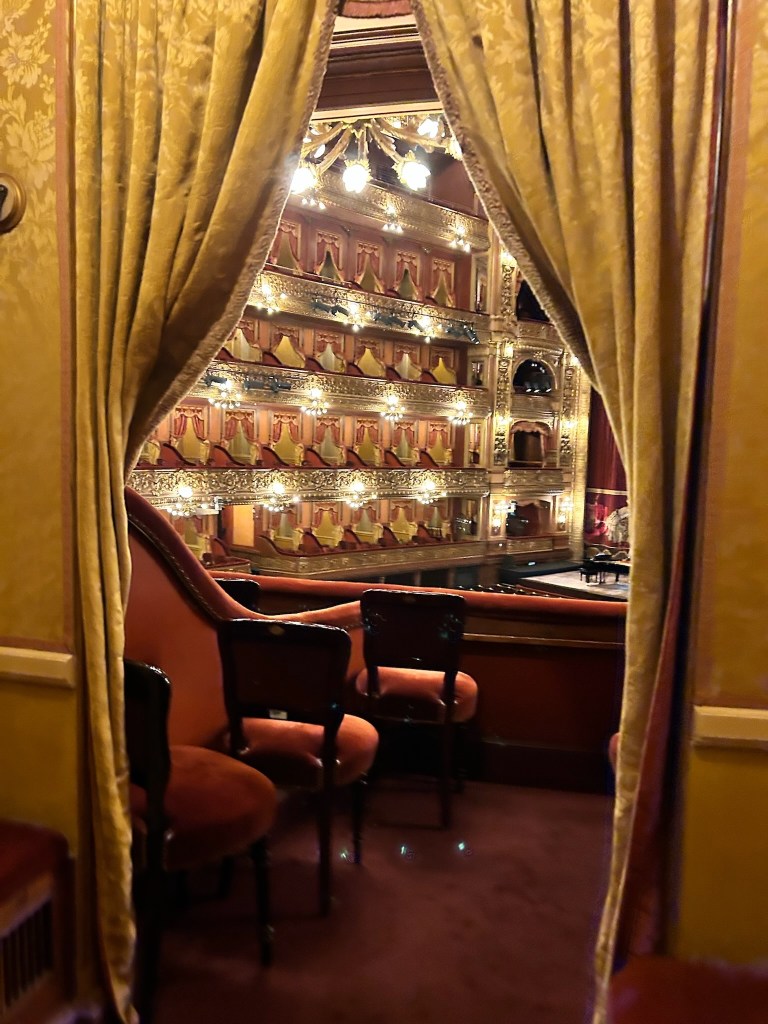
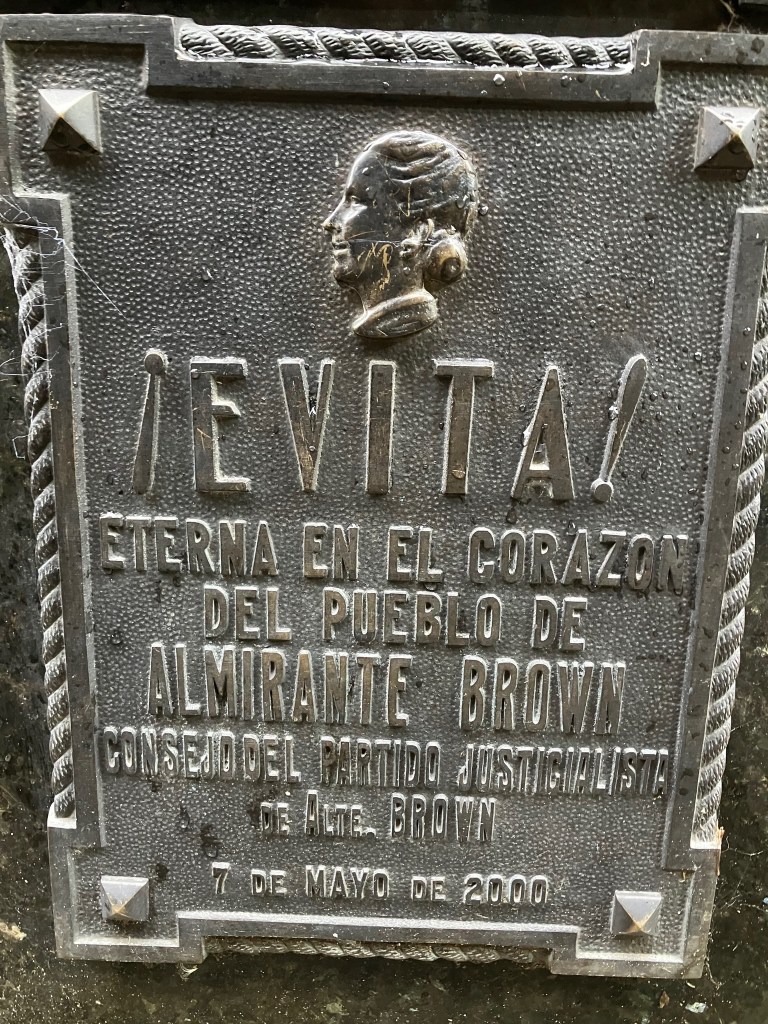
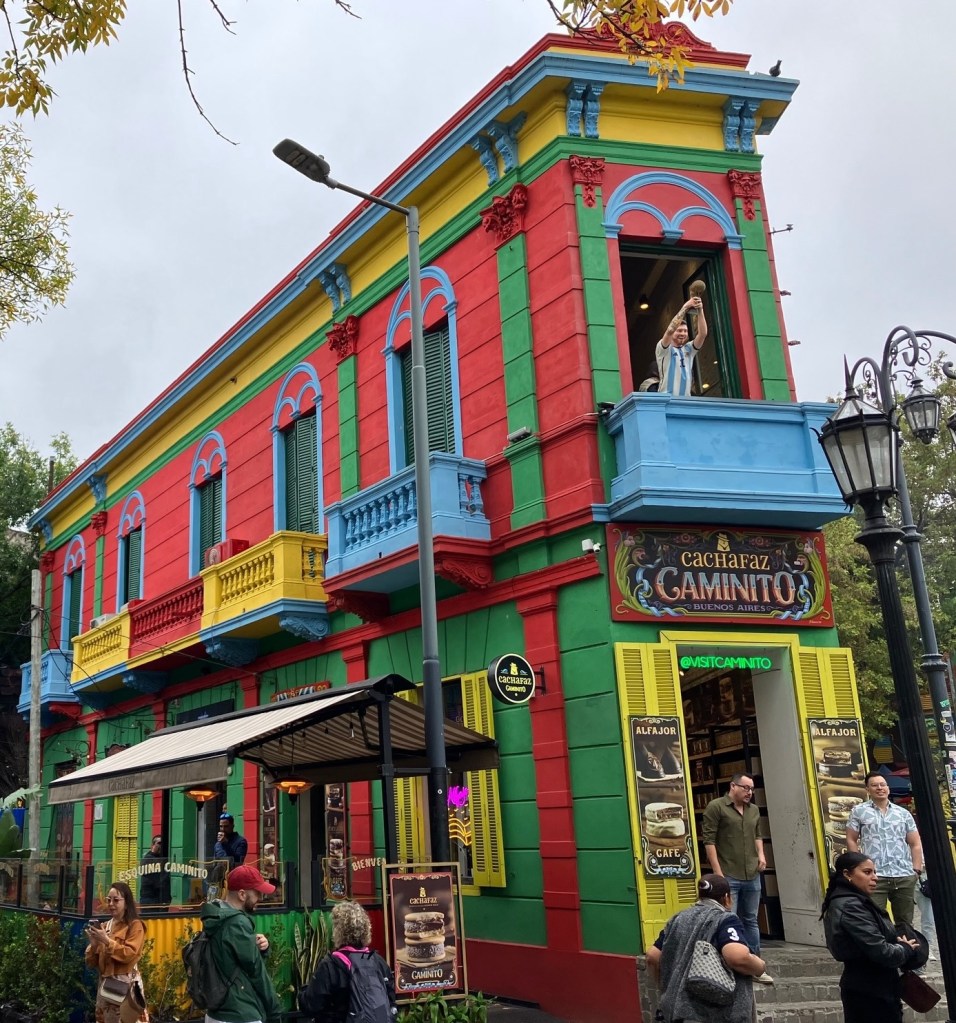
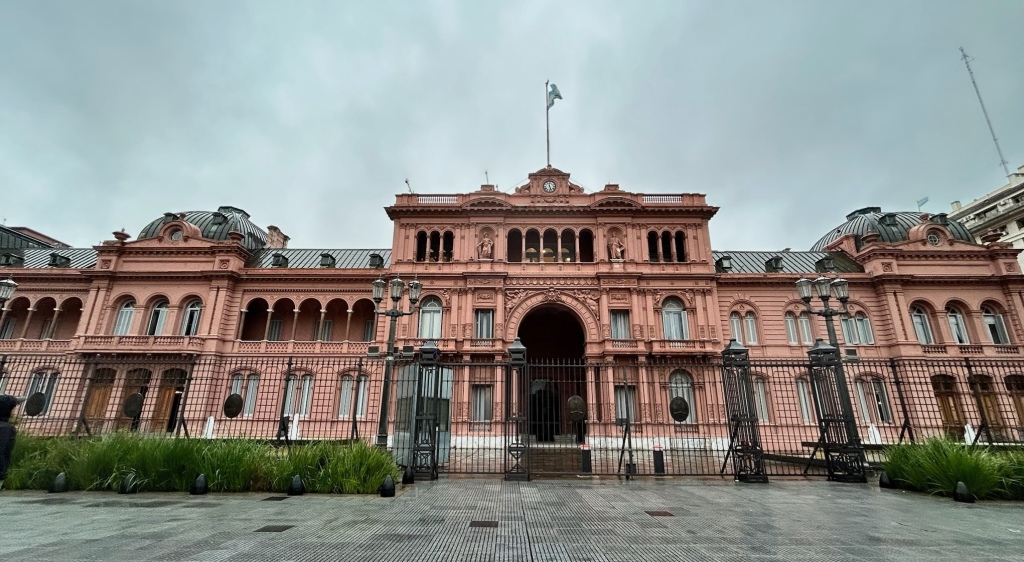
Sacada (an illusion of displacement)
For all its cultural riches, Argentina right now is a bit of a mess. The economy has cratered and social services are minimal. The houseless, the jobless, the trash on the streets are all markers of deeper troubles. Their inflation tsunami makes ours look like a tiny ripple—try 200% in the past year. At one point, we were told, prices were rising so fast that they might change between choosing an item on a store shelf and walking it to the cash register. Argentinian menus still don’t list prices since they would need to print a new menu every day.
When we crossed the Río de la Plata to Uruguay, we found a quirky capital city that has long lived in the shadow of its larger neighbor, but has a stable economy, cleaner streets, and a lively community with its own unique traditions. We did see some people living on the streets, but travel websites that warned of a crime-infested city did not seem to bear out. I took precautions as I would in any city, but never felt unsafe walking the streets. After paying to see a drum concert in Buenos Aires, it was a treat to stumble across a free one in the streets of Montevideo, where candombe is a community arts tradition that brings families out onto the stoops and street corners to drum, dance, eat, drink, and cheer. It would have been great to explore more of Uruguay, but it was time to fly to our next destination.
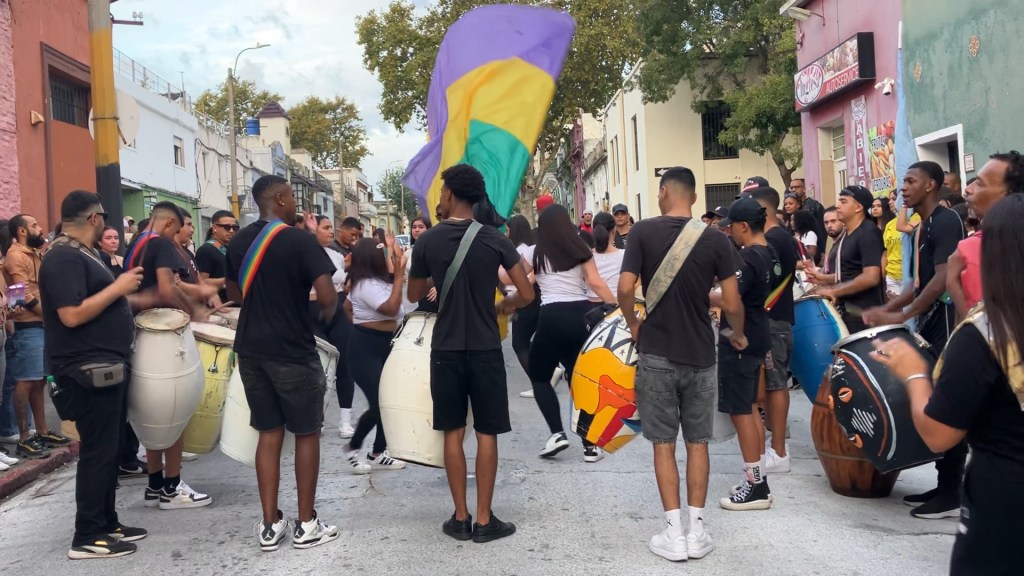
In Mexico City, we found family, warmth, and great food, but after the bout with illness and nearing the end of our odyssey, we mostly just wanted to rest. We craved fresh vegetables and seafood, both of which have been hard to find for the past two months, eating mostly in restaurants. Our bodies were speaking; we needed to listen. We talked about canceling all the plans we had made for May in Chile and heading back to the States to rest, but Maine is still way too cold and the thought of undoing all of our plans was too daunting. We had set ourselves up to have a respite after all this travel and we were looking forward to two weeks in one place on the Chilean coast.
Then when we arrived at the Mexico City airport for our flight to return to Chile, we found that the LATAM airlines app had not adjusted for the different time zones and we had missed the flight. It was almost too much—having girded ourselves for our last flight before two weeks of R&R, only to wait in the airport for over six hours to get help rebooking, pay a fine for making the change, and then have to Uber back to the city for the night and do it all over again the next morning. It added insult to illness, and the empty feeling of having no home base was gnawing at us.
Sanguchito (the “sandwich”—like a hug for your feet)
When our travelers’ tango finally stopped and our swirling bodies paused, we were in Valparaiso, once an important port, and now more of a gritty, bohemian city known for street art and nightlife. Only an hour and a half from Santiago, Valparaiso is also the gateway to nearby Viña del Mar, a beautiful, modern beach city that attracts thousands of well-to-do beachgoers in the summer months to escape Santiago’s heat. We collapsed in our Airbnb and vowed to take it easy here. We took a free walking tour the first day, stocked up on the fresh fruits, vegetables, and comfort food we had been craving, and settled into our 10th-floor apartment with a panoramic view of the city and its harbor. Ahh.
Valparaiso has more than 40 steep hills chockablock with homes and buildings, stacked up the hillsides like multi-colored Lego blocks. Its labyrinthine streets wind around, up, down, and over the hills and valleys. It’s almost like the kids’ board game Chutes and Ladders, with steep staircases for sidewalks, some with concrete slides alongside them for a speedier descent, and some with nearly vertical antique funiculars. The colorful buildings, sidewalks and walls are made of now-decaying cement and pock-marked stucco, often covered with sheets of corrugated metal to keep out the dense fog that can eat away at any porous surface. There is a gently curving shoreline with mountains in the distance and giant sand dunes across the bay. It is a working harbor, with naval ships, cargo ships, fishing vessels, a heli-port, and train tracks along the shore. No fancy boardwalk or shops here – those are found up the road in Viña del Mar.
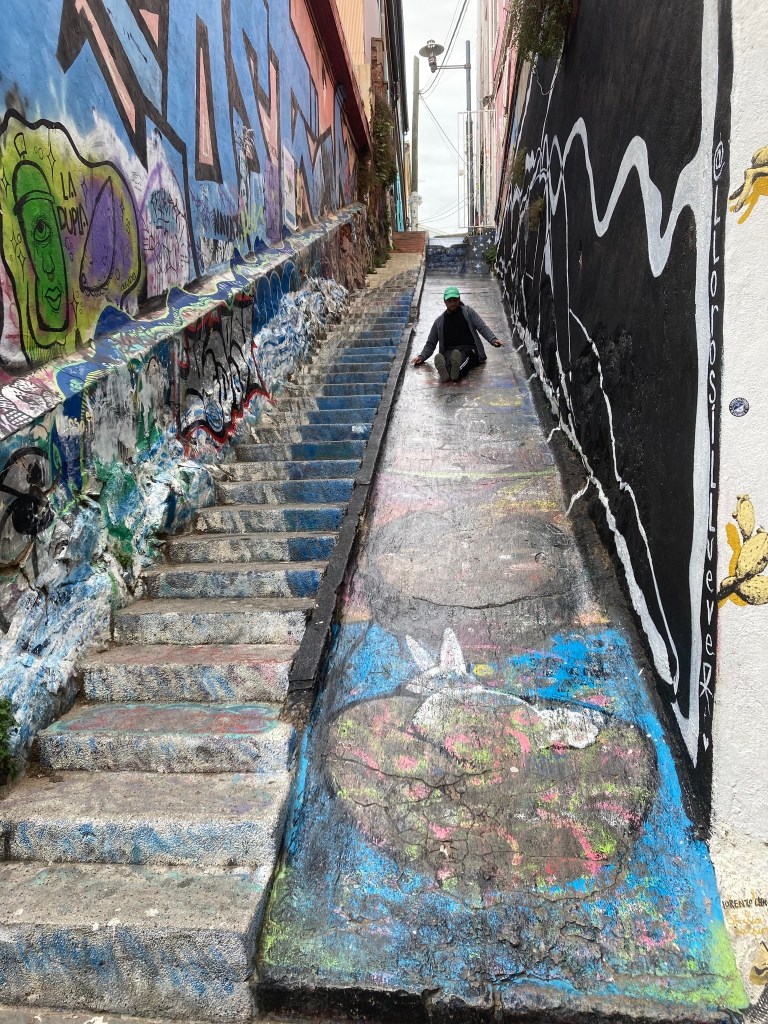
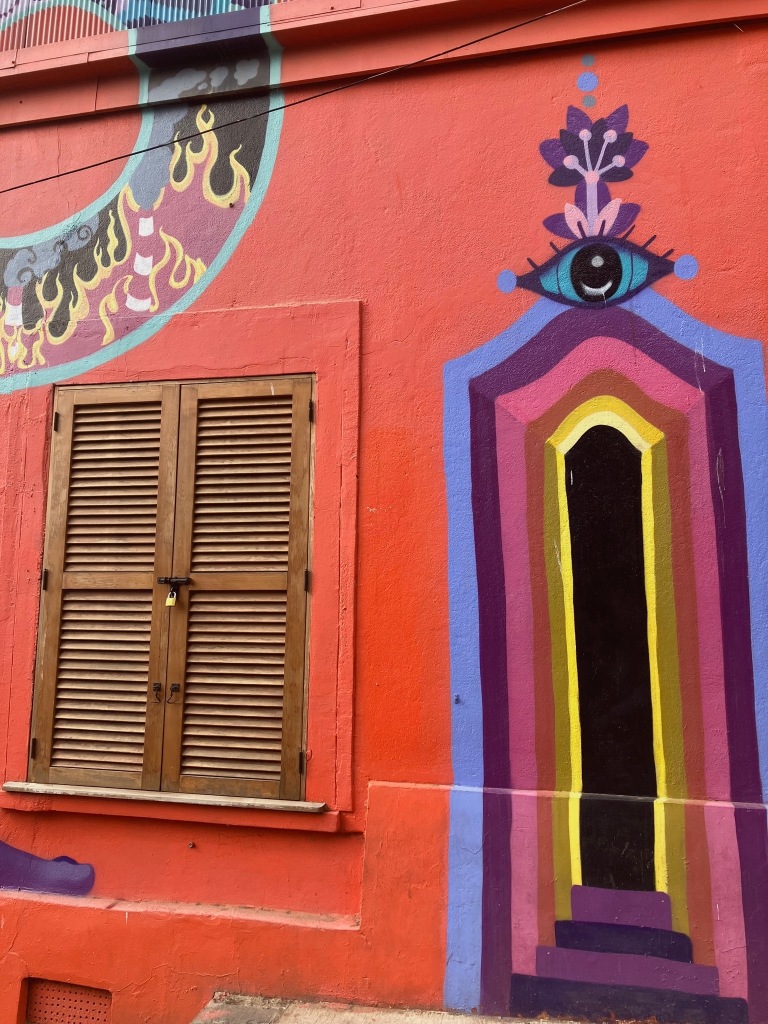
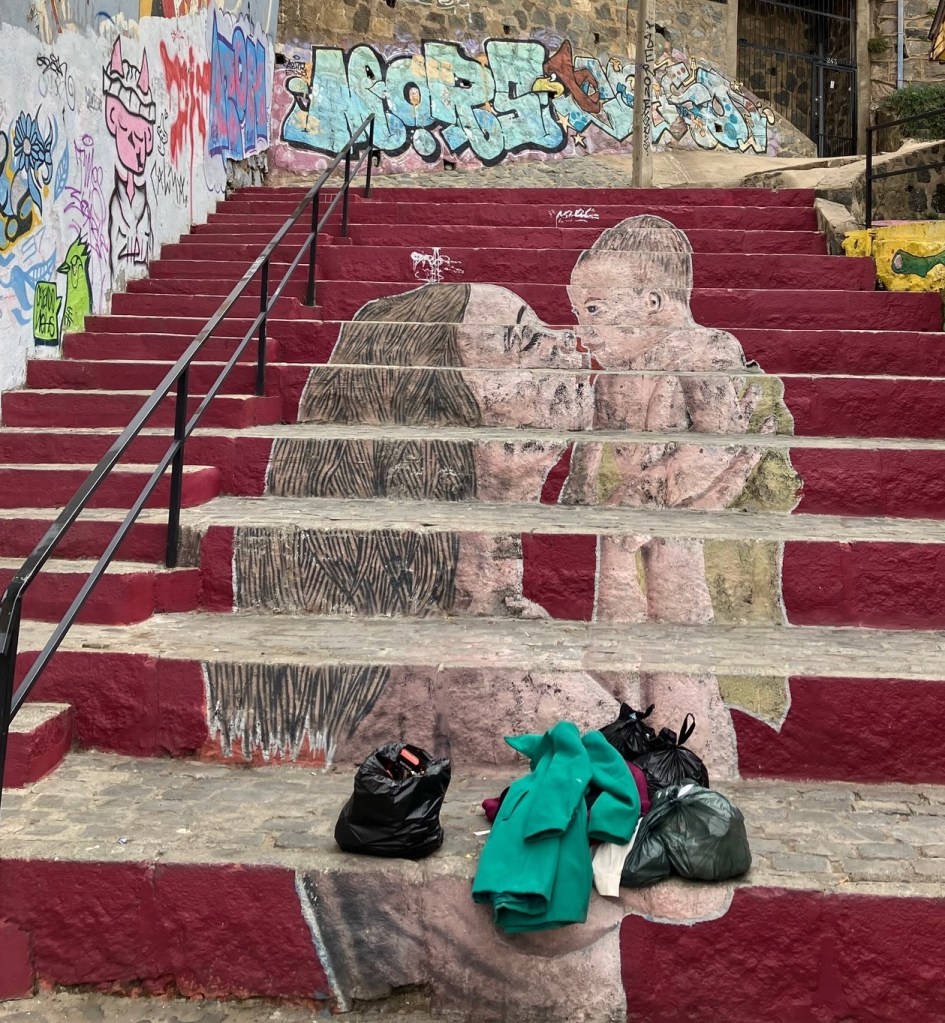
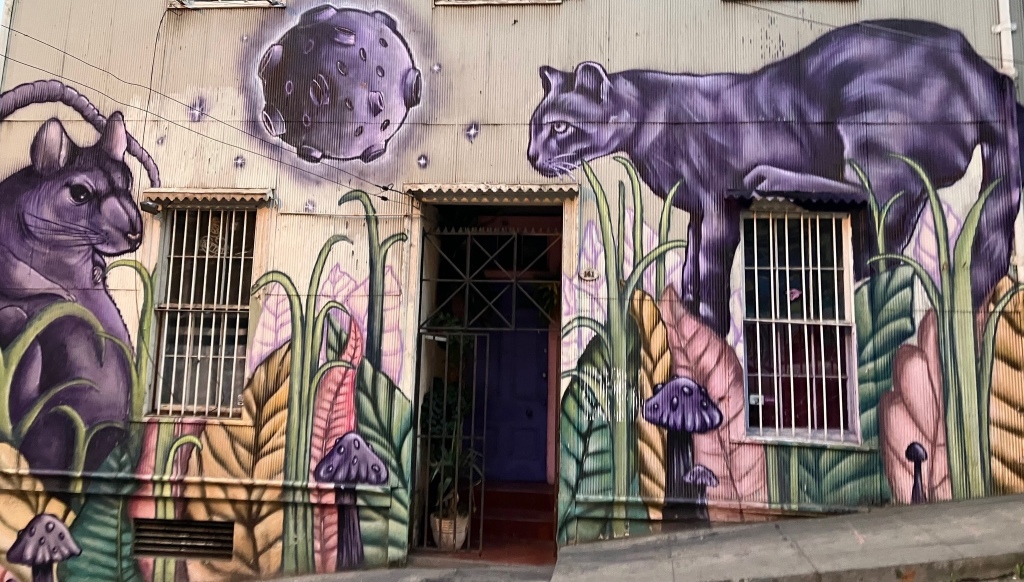
Did I mention the street art? Valparaiso takes this free-flowing art form to a whole new level. We were told there are three kinds: graffiti, tagging, and murals. All are illegal, but seem to be fully tolerated. Graffiti is the spray-painted initials, love declarations, and swears that can be found in any city. Tagging is those colorful balloon-lettered initials that identify the artist in a more eye-pleasing, if hard-to-decipher way. Murals are more professional works of art.
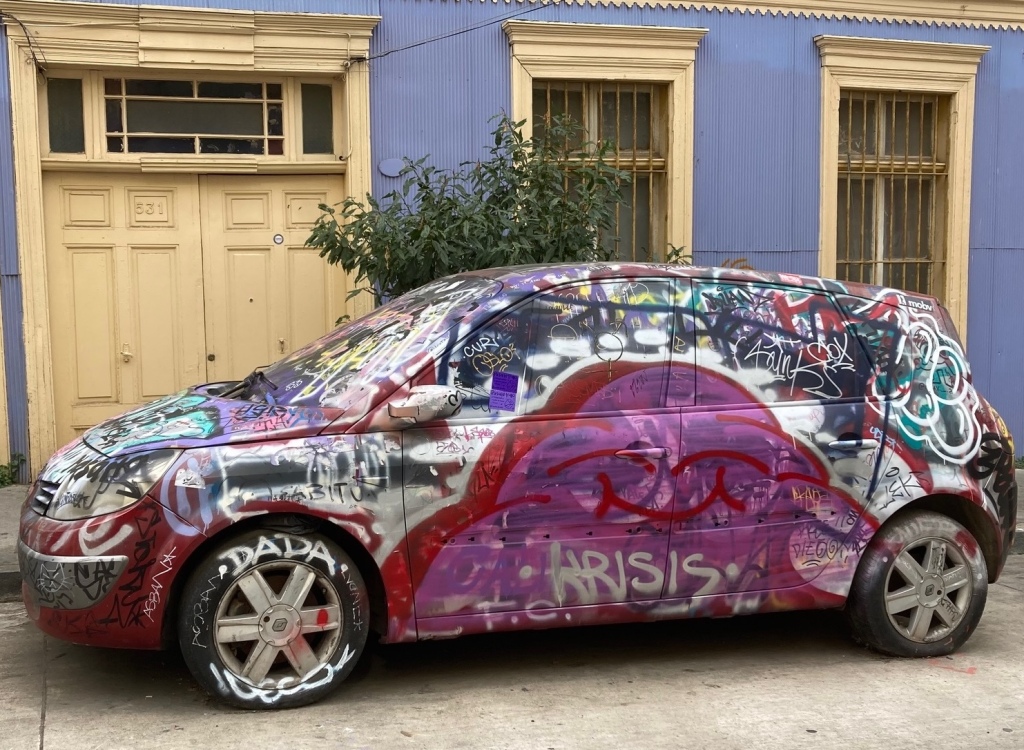
Hiring someone to paint a mural on your outside walls seems to be the only hope for preventing graffiti or tags from appearing there instead. Apparently these artists and vandals (depending on the quality of the art and your perspective) go by an honor code that dissuades taggers from marring murals. And sure enough, all three forms cover nearly every wall in downtown Valparaiso—even churches, statues, and cars that have stayed in one place too long aren’t spared. Locals seem to take it all in stride, and even carry a certain pride in their city’s decorations. And I’ll say this: It may be gritty, but it’s surely an interesting place to walk around.
Pasada (stepping or passing over to the next step)
Here in Valpo, as the locals call it, we have taken a deep breath, gotten out for a walk every day but not much more, and mostly feed ourselves rather than eating at restaurants. Our energy is being restored. This week, we rode the train to the more orderly streets of Viña del Mar, then caught a local bus to climb those dunes we had seen from afar and have lunch at a cafe by the sea. Because we had buffered the day with less-active days on either side, it felt restful and enjoyable to take that excursion. We still plan to see a few local treasures, like Pablo Neruda’s house, but we’re in no rush.
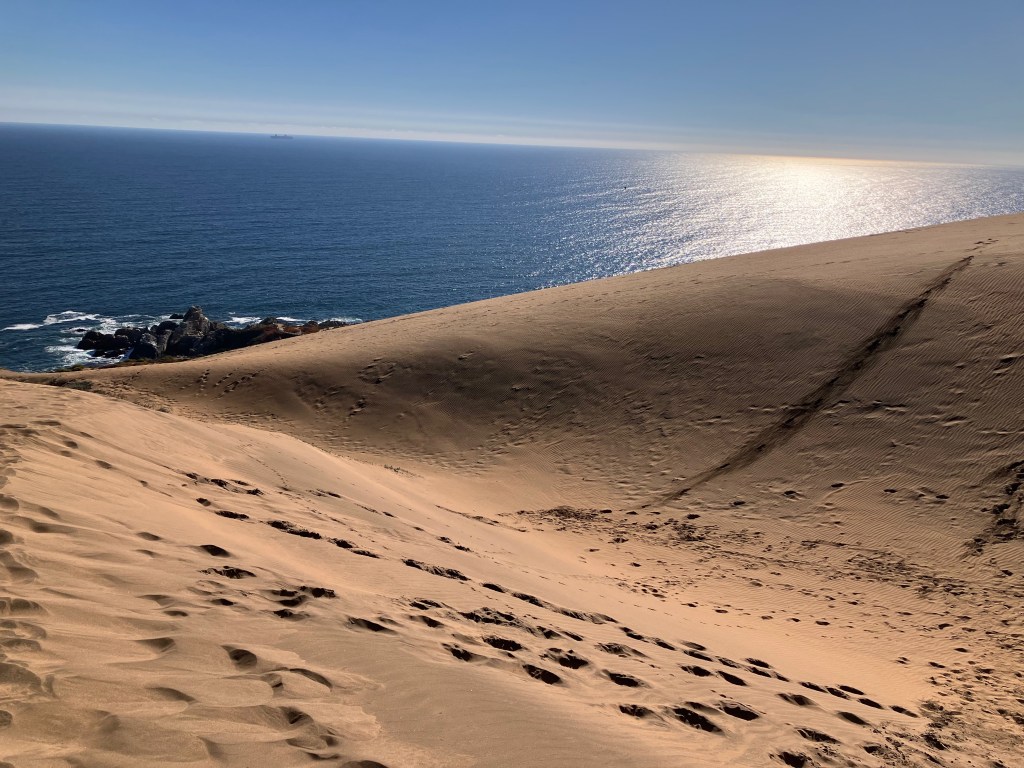
It makes me realize that the traditional advice that “you need four days to see x” is from the perspective of tourists with little time. That’s fine for vacationers, but if you try to do it for too long, it’s exhausting. If we instead give ourselves more time, settle into a base and do less, in the end we’ll have more of a sustainable daily life. I may never (okay: will never) learn the tango, but we are both learning a lot every year about traveling. We knew when we planned these two months that we’d need some time to relax at the end, but we had no idea just how much until we had done it. I’ve learned that, not only is it tiring, but I am less able to appreciate what a place has to offer if we’re go-go-go the whole time we’re there.
Tangos end with an embrace, and I think this dance would have felt unfinished had we given into our exhaustion and returned to the States. We needed a chance to embrace our final month in Chile—after a nice, relaxing break.
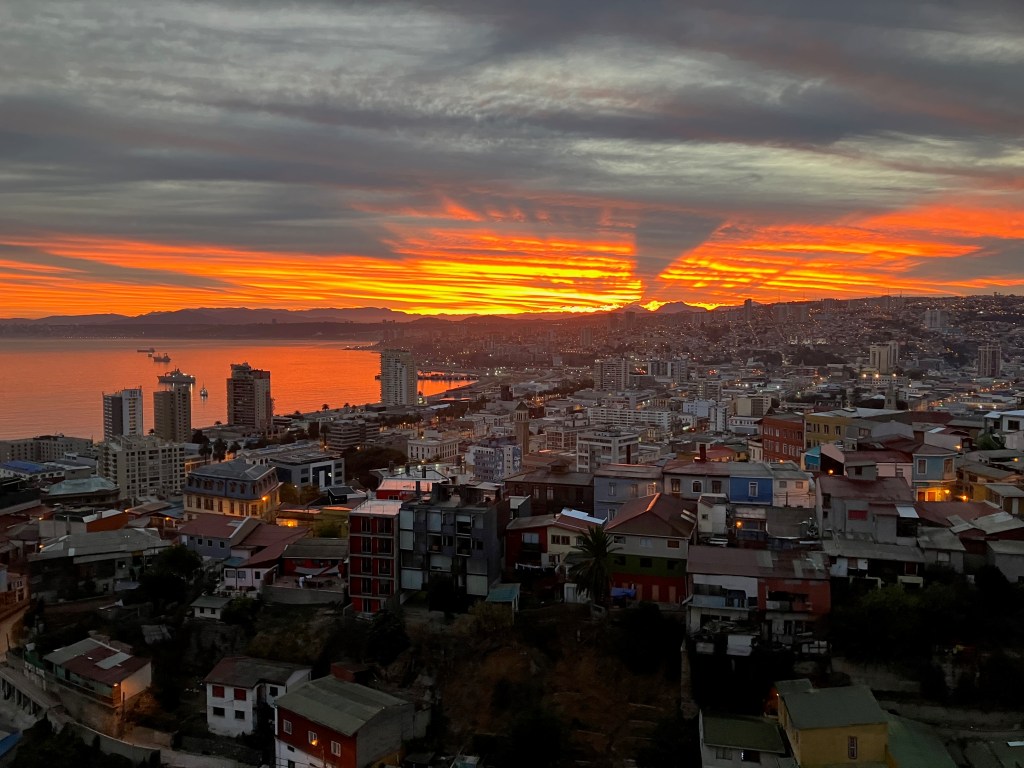
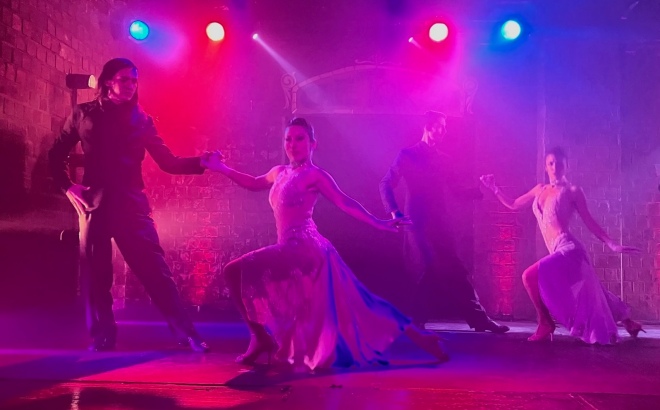
Dear Al and Rachel,
Thank you for the amazing entry in your blog. I could hear the music of the Tango in your descriptions. I could appreciate all the research and flexibility you bring to your adventures. I’m at the edge of my seat absorbing your adventures and awaiting the next.
Lane
LikeLiked by 1 person
The relentless beat, the rhythm of your discoveries (murals, vistas, interactions), the exhaustion from one song too many, then you look into each other’s eyes and out at the sunset and find peace. Love it!
LikeLiked by 1 person
I fully appreciate the value of the coda. Your readers as well as yourselves will also fully appreciate it, I mean FULLY, when they are, as I am octogenarians.
vicariously, yours,
les
LikeLiked by 1 person
It looks like we have been tangoing around each other! We were in Santiago when you were in La Serena and my last blog post was about Valparaiso as well. 🙂
https://www.roamingabout.com/valparaiso-in-chile-a-colorful-day-trip-from-santiago/
Argentina has been tough on us, with the ever increasing prices. Menus have stickers on them that constantly change. It has affected our budget even more than usual and we keep eating out to a bare minimum and pick only the things we really need at grocery stores. And that after looking forward to visiting this country in our camper for a long time, hearing how affordable it was down here. Last year…
Anyway, I’m glad you enjoyed your time off and look forward to finding out where you spent your last month in Chile.
LikeLike
Thanks Liesbet — we look forward to looking at your post! And yes, we also heard that inflation has been so bad in Argentina in the last year or so. Have you thought about heading into Uruguay?
LikeLiked by 1 person
Yes, we plan on doing that in September, but we won’t be able to stay long, because of the high cost of living. Probably two weeks to hit the highlights. 🙂
LikeLike
Hi Both
A lovely piece of writing, as always, and one that I could clearly relate to. We returned from our two months in Chile and a little of Argentina and I’ve since often commented that it felt quite tiring with all the planes, various car hires, the ferry etc and always looking for accommodation ‘on the hoof’. Enjoyable but maybe at an easier pace next time. The times I remember best are when we had 4 or 5 nights somewhere and could just ‘be’, just absorb the local scene and, like you, shop and cook for ourselves. Looking forward to your next post,
happy hugs,
Mike and Kristina
LikeLike
Thanks for the comment Mike and Kristina! I think for me 5 nights is about the minimum I’d prefer for most places and 10 is even better if we have the time. Of course, in some places you’re ready to move on more quickly than others…
LikeLike